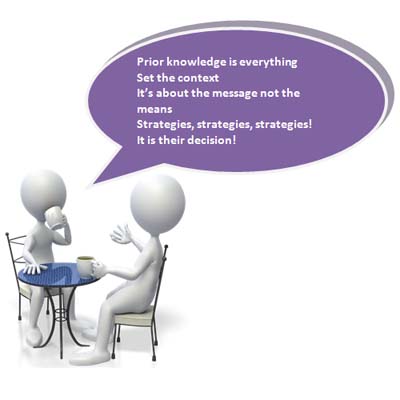Tell me and I will forget, Show me and I might remember, Involve me and I will understand.
Benjamin Franklin
Five more ideas to keep communicating
1. Prior knowledge is everything.
Ensure you know as much as possible about the person and their ‘back story’. It is far better to say ‘oh you have two sons, don’t you?’ than to ask the open question ‘do you have any children?’ Life story work is vital in maintaining communication and either encourage its development or where one has been produced promote its use
2. Set the context.
Back up what you say with reference to an object or pictures/photos. This helps to focus the person’s attention and also by putting the focus ‘out there’, it takes pressure off the person to communicate verbally and generally results in better interactions.
3. It’s about the message not the means!
Accept and encourage any form of communication that gets the message across – gesture, drawing, getting an object.
4. Strategies, strategies, strategies!
When a person with dementia has difficulty finding a word, encourage them to:
- Use gestures or drawing to get the meaning across
- Ask them questions e.g. is it X or Y
- Encourage the person to circumlocute (talking around the target word) so that the person can describe the object/place that cannot be named
- If you think you know the word, ask the person if they would like you to supply it. Always allow plenty of time for the person to respond but when you sense frustration, find a way to move on.
- Encourage the person to develop lists as aids such as shopping lists, regular places they visit, family names and birthdays etc. and then the persons conversational partner can check through these with them to get the target word.
Remember that a strategy may work some of the time but not all of the time. It is important to alternate strategies.
5. It is their decision!
Giving people the opportunity to be part of the decision process about care is vitally important. Talking Mats is a communication framework that facilitates people to express their views. It provides a method of helping people to organise their thoughts and express them using visual symbols, a scale and a mat for presentation.
Finally
In these two blog posts I have been able to share with you some of my specific techniques that can enhance the communication process with people with dementia. However, we must never lose sight of the fact that everyone is an individual who will have had different styles and skills at communicating prior to the onset of dementia.
There may be a time when, if you have dementia or are caring for someone with dementia, you consider that the dementia is impacting on communication. If this is the case it may be important to get an accurate assessment of the person’s communication strengths and challenges, from a speech and language therapist. This enables strategies to be specifically tailored to the individual.
The Standards of Care in Dementia (2011) states:
‘That staff use a variety of communication aids to help communication, including the use of life story books, talking mats, digital stories, interpreters as appropriate and referral to speech and language therapy.’ (page 15)
If you are concerned speak to your GP or team that are working with you just now to find out how to refer to a speech and language therapist in your local area.
As in my previous blog post I am going to invite you to offer
- suggestions and comments to my final 5 ideas and tips?
- share your own ideas and tips that you use to enable people with dementia to communicate their hopes, desires and wishes?
References
Standards of Care in Dementia 2011 www.scotland.gov.uk/Publications/2011/05/31085414/0
Talking Mats www.talkingmats.com
Supporting links
www.nes.scot.nhs.uk/making-communication-even-better/
 Joy Harris
Joy Harris
SLT,Clinical Lead for Dementia, Lothian
@joysltdem
I work in East and Midlothian Psychiatry of Old Age teams seeing people with communication and/ or swallowing problems from the point of diagnosis of Dementia, and at any stage throughout the patient journey as the need arises.


